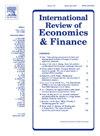超越临界点:材料可持续性对投资效率的非线性影响
IF 4.8
2区 经济学
Q1 BUSINESS, FINANCE
引用次数: 0
摘要
根据可持续会计准则委员会(SASB)采用的股东观点来确定重要性,我们提出并检验了将财务资源分配给优先考虑环境、社会和治理因素的项目(即可持续投资)的最佳水平的假设。基于股东考虑可持续投资的特定阈值的前提,我们假设如果公司的可持续投资低于最优水平,股东的反应是积极的,而如果投资高于最优水平,股东的反应是消极的。利用二次回归和分段线性回归,我们证明了2008年至2021年在ASSET4上市的所有美国公司样本中,可持续性的重要性评级与资本投资效率之间存在显著的倒u型联系。在进一步考察拐点对企业和市场特定特征的敏感性后,我们发现杠杆企业和面临外生冲击的企业具有更高的最优水平。我们的结果在一系列敏感性测试中保持稳健,并为监管机构和标准制定者提供了重要的政策启示。这些发现可以为美国证券交易委员会(SEC)、SASB和国际可持续性标准委员会(ISSB)等组织制定的框架和指南提供信息。本文章由计算机程序翻译,如有差异,请以英文原文为准。
Beyond the tipping point: The nonlinear impact of material sustainability on investment efficiency
Drawing on the shareholder viewpoint adopted by the Sustainability Accounting Standards Board (SASB) to determine materiality, we propose and test a hypothesis for the optimal level of allocating financial resources to projects prioritizing environmental, social, and governance factors, namely sustainability investment. Based on the premise that shareholders consider specific thresholds for sustainability investments, we postulate that shareholders respond positively if the firm's sustainability investments are below the optimal level, whereas they react negatively if the investments are above the optimal level. Using a quadratic and piecewise linear regression, we demonstrate a significant inverted U-shaped linkage between materiality ratings of sustainability and capital investment efficiency for a sample of all U.S. companies listed on ASSET4 spanning from 2008 to 2021. Upon further examination of the sensitivity of the turning point to firm- and market-specific characteristics, we find that leveraged firms and those facing exogenous shocks have a higher optimal level. Our results remain robust across a range of sensitivity tests and offer significant policy implications for regulators and standard setters. These findings can inform the frameworks and guidelines developed by organizations such as the U.S. Securities and Exchange Commission (SEC), the SASB, and the International Sustainability Standards Board (ISSB).
求助全文
通过发布文献求助,成功后即可免费获取论文全文。
去求助
来源期刊
CiteScore
7.30
自引率
2.20%
发文量
253
期刊介绍:
The International Review of Economics & Finance (IREF) is a scholarly journal devoted to the publication of high quality theoretical and empirical articles in all areas of international economics, macroeconomics and financial economics. Contributions that facilitate the communications between the real and the financial sectors of the economy are of particular interest.

 求助内容:
求助内容: 应助结果提醒方式:
应助结果提醒方式:


